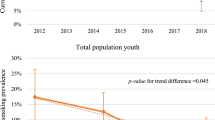Abstract
Background
Evaluating the progress of tobacco control across the world heavily relies on smoking prevalence estimates. Those estimates are often based on surveys of self-reported cigarette smoking status. The accuracy varies among populations with different social and cultural backgrounds.
Purpose
The objective of this study was to estimate the prevalence of smoking and assess the accuracy of self-report smoking status in Chinese adolescents.
Method
This population-based cross-sectional survey included 10,934 adolescents aged 12 to 18 years from 17 schools in Shanghai, China. Data on adolescents’ smoking status were collected from adolescents’ self-reporting and from parents’ questionnaires, separately. Based on the data of two sources, the total number of smokers among the study participants was estimated using a capture–recapture method.
Results
Among 5,452 girls and 5,482 boys, the prevalence estimates of self-reported smoking were 13.6 % (748) and 5.2 % (284) for boys and girls, respectively. Parents only identified smaller proportions of smoking adolescents: 2.9 % (160) boys and 0.6 % (30) girls. Using the capture–recapture method, we estimated the prevalence of smoking as 18.3 % (95 % CI 16.4, 20.3) for boys and 14.2 % (95 % CI 7.6, 20.8) for girls.
Conclusion
Reliance on self-reporting to identify smokers among Chinese adolescents significantly underestimates the number of smokers, particularly among Chinese girls. Self-reported smokers only represent less than half of actual smokers in girls. Our findings are important for monitoring smoking trends and evaluating tobacco control interventions among Chinese adolescents.


Similar content being viewed by others
References
Giovino GA, Mirza SA, Samet JM, Gupta PC, Jarvis MJ, Bhala N, et al. Tobacco use in 3 billion individuals from 16 countries: an analysis of nationally representative cross-sectional household surveys. Lancet. 2012;380(9842):668–79.
Yang G, Fan L, Tan J, Qi G, Zhang Y, Samet JM, et al. Smoking in China: findings of the 1996 National Prevalence Survey. JAMA. 1999;282(13):1247–53. doi:10.1001/jama.282.13.1247.
Yang GH, Ma JM, Liu N, Zhou LN. [Smoking and passive smoking in Chinese, 2002]. Chin J Epidemiol. 2005;26(2):77–83.
Qian J, Cai M, Gao J, Tang S, Xu L, Critchley JA. Trends in smoking and quitting in China from 1993 to 2003: National Health Service Survey data. Bull World Health Organ. 2010;88(10):769–76. doi:10.2471/BLT.09.064709.
Gorber SC, Schofield-Hurwitz S, Hardt J, Levasseur G, Tremblay M. The accuracy of self-reported smoking: a systematic review of the relationship between self-reported and cotinine-assessed smoking status. Nicotine Tob Res. 2009;11(1):12–24. doi:10.1093/ntr/ntn010.
Wong SL, Shields M, Leatherdale S, Malaison E, Hammond D. Assessment of validity of self-reported smoking status. Health Rep. 2012;23(1):47–53.
Yeager DS, Krosnick JA. The validity of self-reported nicotine product use in the 2001–2008 National Health and Nutrition Examination Survey. Medical care. 2010;48(12):1128–32. doi:10.1097/MLR.0b013e3181ef9948.
West R, Zatonski W, Przewozniak K, Jarvis MJ. Can we trust national smoking prevalence figures? Discrepancies between biochemically assessed and self-reported smoking rates in three countries. Cancer Epidemiol Biomarkers Prev. 2007;16(4):820–2. doi:10.1158/1055-9965.EPI-06-0679.
Lee CY, Shin S, Lee HK, Hong YM. Validation of self-report on smoking among university students in Korea. Am J Health Behav. 2009;33(5):540–9.
Patrick DL, Cheadle A, Thompson DC, Diehr P, Koepsell T, Kinne S. The validity of self-reported smoking: a review and meta-analysis. Am J Public Health. 1994;84(7):1086–93.
Jung-Choi KH, Khang YH, Cho HJ. Hidden female smokers in Asia: a comparison of self-reported with cotinine-verified smoking prevalence rates in representative national data from an Asian population. Tob Control. 2011. doi:10.1136/tobaccocontrol-2011-050012.
Global Youth Tobacco Survey Collaborative Group. Tobacco use among youth: a cross country comparison. Tob Control. 2002;11(3):252–70.
Chao A, Tsay PK, Lin SH, Shau WY, Chao DY. The applications of capture–recapture models to epidemiological data. Stat Med. 2001;20(20):3123–57.
Corrao G, Bagnardi V, Vittadini G, Favilli S. Capture–recapture methods to size alcohol related problems in a population. J Epidemiol Community Health. 2000;54(8):603–10.
StataCorp. Stata Statistical Software: Release 12. College Station, Texas: StataCorp LP; 2011.
Lewis SJ, Cherry NM, Mc LNR, Barber PV, Wilde K, Povey AC. Cotinine levels and self-reported smoking status in patients attending a bronchoscopy clinic. Biomarkers. 2003;8(3–4):218–28. doi:10.1080/1354750031000120125.
World Health Organization. WHO report on the global tobacco epidemic, 2008: the MPOWER package. Geneva: World Health Organization; 2008.
Yang G, Ma J, Chen AP, Brown S, Taylor CE, Samet JM. Smoking among adolescents in China: 1998 survey findings. Int J Epidemiol. 2004;33(5):1103–10. doi:10.1093/ije/dyh225.
Acknowledgments
The authors wish to thank the study participants for their contribution to the research.
Funding
This publication is based on research funded in part by the Bill & Melinda Gates Foundation. The findings and conclusions contained within are those of the authors and do not necessarily reflect positions or policies of the Bill & Melinda Gates Foundation. Z.W. was supported by NHMRC of Australia (511013 and APP1042343).
Conflict of Interest
The authors declare that they have no conflicts of interest.
Ethical Approval
This study is approved by the Shanghai Jiao Tong University School of Public Health Research Board.
Author information
Authors and Affiliations
Corresponding author
Rights and permissions
About this article
Cite this article
Ma, J., Zhu, J., Li, N. et al. Severe and Differential Underestimation of Self-reported Smoking Prevalence in Chinese Adolescents. Int.J. Behav. Med. 21, 662–666 (2014). https://doi.org/10.1007/s12529-013-9326-x
Published:
Issue Date:
DOI: https://doi.org/10.1007/s12529-013-9326-x




